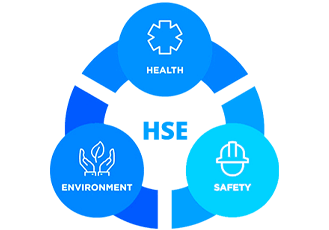Every organization, regardless of size or industry, faces health, safety, and environmental challenges. Addressing these isn’t just about meeting legal requirements; it’s about building a safer workplace and a sustainable future. An HSE Policy is your organization’s cornerstone for achieving these goals.
But what exactly goes into crafting an HSE policy that works? It’s not just about putting words on paper. It’s about creating a practical and enforceable document that reflects your organization’s values and operations.
In this guide, we’ll walk you through what an HSE policy is, why it’s essential, how to create one, and even provide examples for specific industries to inspire you.
What is an HSE Policy?
An HSE Policy (Health, Safety, and Environment Policy) is a formal statement outlining an organization’s commitment to workplace health, safety, and environmental protection. It defines the principles, responsibilities, and actions your organization will follow to ensure the well-being of its employees, protect the environment, and comply with regulations.
In simpler terms, an HSE policy serves as a roadmap. It guides everyone in the organization—management, employees, and contractors—on what is expected to maintain a safe and sustainable workplace.
Why is an HSE Policy Important?
An HSE policy isn’t just a regulatory requirement; it’s a business necessity. Here’s why:

Key Components of an HSE Policy
A comprehensive HSE policy typically includes these components:
1. Introduction
- State your organization’s commitment to health, safety, and the environment.
- Example: “Our company is dedicated to maintaining the highest standards of safety and environmental responsibility in all operations.”
2. Policy Scope
- Define who the policy applies to (employees, contractors, visitors) and the areas it covers (worksites, offices, etc.).
3. Objectives
- Outline measurable goals, such as reducing incident rates by 10% annually or achieving zero environmental spills.
4. Roles and Responsibilities
- Specify the roles of management, employees, and safety officers.
- Example: “Managers are responsible for ensuring their teams follow safety procedures, while employees must report hazards immediately.”
5. Risk Management
- Describe how risks will be identified, assessed, and controlled.
- Example: “All tasks will be preceded by a hazard identification and risk assessment (HIRA) process.”
6. Legal and Regulatory Compliance
- Reference the regulations and standards your organization adheres to, such as ISO 45001 or OSHA guidelines.
7. Monitoring and Review
- Commit to regular reviews and updates of the policy.
- Example: “This policy will be reviewed annually or following any significant incident.”
Steps to Create an HSE Policy
Creating an effective HSE policy involves the following steps:
Examples of HSE Policies for Select Industries
Challenges in Implementing an HSE Policy
While having an HSE policy is crucial, implementation can be challenging. Common obstacles include employee resistance, lack of resources, and gaps in communication. Overcoming these requires leadership buy-in, ongoing training, and continuous engagement with employees at all levels.
Making Your HSE Policy Work
Having an HSE policy on paper is just the beginning. Its real value lies in how effectively it’s implemented and embraced throughout your organization. Here are some practical steps to ensure your HSE policy becomes a living, breathing part of your workplace culture:
1. Communicate Clearly
Make your HSE policy accessible to everyone. Share it through multiple channels, such as company meetings, emails, and noticeboards. Ensure all employees, contractors, and visitors are aware of the policy and understand their role in upholding it.
2. Provide Regular Training
Education is the foundation of successful implementation. Conduct training sessions that cover key aspects of the policy, such as hazard identification, emergency response, and proper use of safety equipment. Tailor the training to specific job roles to make it relevant and engaging.
3. Lead by Example
Leadership plays a critical role in making the policy work. When managers and supervisors prioritize health, safety, and environmental practices, employees are more likely to follow suit. Show your commitment by participating in training sessions and adhering to the policy’s guidelines.
4. Integrate into Daily Operations
Embed the HSE policy into everyday workflows. For instance, include safety checklists in project planning, conduct routine inspections, and make risk assessments a standard part of task assignments. Integration ensures the policy isn’t just a standalone document but an active part of your processes.
5. Monitor and Measure Progress
Track the effectiveness of your HSE policy using key performance indicators (KPIs). These could include incident rates, near-miss reports, or environmental metrics like waste reduction. Regular monitoring helps identify areas for improvement and highlights successes that can be celebrated.
6. Encourage Employee Engagement
Employees are the backbone of any HSE policy. Foster a culture where workers feel comfortable reporting hazards, suggesting improvements, and taking ownership of safety practices. Consider setting up a feedback system or incentive program to motivate participation.
7. Conduct Regular Reviews
An HSE policy isn’t static. Schedule periodic reviews to ensure it remains relevant as your organization grows or as new risks and regulations emerge. Involve a cross-functional team in these reviews to get diverse perspectives and ensure the policy evolves effectively.
8. Leverage Technology
Use tools like safety management software to streamline the implementation of your HSE policy. Digital solutions can help automate workflows, track compliance, and generate reports, saving time while improving accuracy.
9. Recognize and Reward Compliance
Acknowledge individuals or teams who actively follow the policy and contribute to a safer workplace. Recognition can be as simple as verbal appreciation or as formal as an award program. Positive reinforcement encourages others to do the same.
10. Prepare for the Unexpected
No policy is foolproof. Ensure your organization is prepared to handle emergencies by conducting drills and maintaining up-to-date response plans. Test your HSE protocols regularly to identify and address any gaps.
By integrating these steps, you can transform your HSE policy into more than just a document—it becomes a mindset and a culture that drives safety, compliance, and sustainability throughout your organization.
Conclusion
An HSE policy is more than just a document—it’s a reflection of your organization’s values and commitment to safety and sustainability. By taking the time to craft a thoughtful, actionable policy and ensuring its effective implementation, you protect your people, meet legal obligations, and contribute to a healthier environment.
Remember, the journey to a safer workplace begins with clear commitments and consistent action. Whether you’re in construction, healthcare, or any other industry, a well-crafted HSE policy is your first step toward a safer, more sustainable future.


















